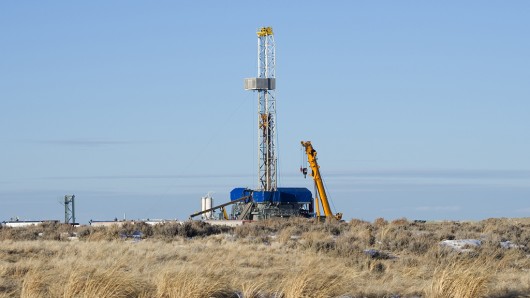
Dry fracturing promises to open up shale fields without ground water contamination (Photo: Shutterstock)
“Fracking” may sound like something out of Battlestar Galactica, but it’s actually short for “hydraulic fracturing.” It is one of the most remarkable success stories in the history of the energy industry and its ability to open up previously unprofitable oil and gas resources in North America, Europe and China holds the promise of centuries of cheap, clean and abundant energy free of Middle Eastern control. However, it has raised the concerns of some environmentalists. Chimera Energy Corporation of Houston, Texas, has announced that they are licensing a new method for extracting oil and gas from shale fields that doesn't contaminate ground water resources because it uses exothermic reactions instead of water to fracture shale.
Hydraulic fracturing works by pumping hundreds of thousands of gallons of water down shafts to deep-lying shale beds. The water is pumped at pressures of up to 15,000 psi (1,000 ATM), which cracks the shale, forming fissures that allow any gas or oil trapped in it to flow freely. It’s opened up fields previously thought worthless that now promise to yield trillions of barrels of oil and far more natural gas. However, it has raised concerns about how environmentally safe it is.
Despite the fact that fracking is used mainly in deep, sealed geological deposits, there is the fear that it may pose a danger to groundwater. Depending on the method involved and the type of oil field, various other materials are added to the water used in Fracking, such as sand, foaming agents, gels and friction reducers. The concern is that the water, which is pumped out after the process, may either leak these substances plus radioactive radon from the well directly into aquifer layers, or contaminate water supplies after pumping out.
For this reason, some fracking engineers prefer non-hydraulic methods. One of these, used recently in New York State, swaps the water for gelled propane. The idea being that the propane reverts to a gas at the end of the process and can be pumped out, leaving any additives behind in the well, much like boiling seawater and leaving behind the salt.
The Chimera process takes this a step further by eliminating any working liquid. Details of the process have not been made public yet due to patent concerns, but Chimera Energy uses what is called “dry fracturing” or “exothermic extraction.” First developed in China, this involves using hot gases rather than liquid to fracture the shale. This was originally intended for wells in arctic regions where water used in fracking freezes, but Chimera Energy has developed it for general use.
In dry fracturing, metal oxides, ultra-expansive evaporants and pumice are pumped into the well. The metal oxides react with one another to form an exothermic reaction. Extremely hot gases are generated that expand and crack the shale. Meanwhile, the pumice shoots in and reinforces the fractures, keeping them from closing and allowing the gas or oil to flow.
Chimera Energy claims that not only is the technique environmentally safe, but that it is compatible with any existing well in the world.
Source: Chimera Energy Corporation
Copyright © gizmag 2003 - 2012 To subscribe or visit go to: http://www.gizmag.com
